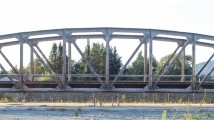Abstract
The Federal Highway Administration requires that highway bridges in the US be inspected at least every 2 years. A research investigation at the University of Texas at Austin aims to develop a wireless data acquisition system that can be used to monitor the response of steel bridge systems in an economic manner and thereby enhance this traditional inspection process. Wireless systems feature many advantages, such as minimizing the amount of wire required and reducing installation costs. However, there are also a number of challenges associated with implementing wireless systems and the research team has previously experienced communication difficulties when using wireless data acquisition systems to monitor steel highway bridges. Radio frequency (RF) studies were conducted to determine if wireless networks using IEEE 802.15.4 radios provide reliable communication in steel bridge environments. Measurements were also taken to determine the impact on the network performances using four types of antennas. While improvements in network performance were observed using high-gain antennas in an open field, the performance improvements were inconsistent when used on steel bridges and therefore their use is not recommended.











Similar content being viewed by others
References
USDOT. (2004) Status of the nation’s highways, bridges, and transit: conditions and performance. Retrieved from http://www.fhwa.dot.gov/policy/2004cpr/
Lynch J, Sundararajan A, Law K, Kiremidjian A, Carryer E (2004) Embedding damage detection algorithms in a wireless sensing unit for operation power efficiency. Smart Mater Struct 13(4):800–810
Lynch J, Loh K (2006) A summary review of wireless sensors and sensor networks for structural health monitoring. Shock Vibration Digest 38(2):91–128
Whelan M, Gangone M, Janoyan K, Jha R (2009) Real-time wireless vibration monitoring for operational modal analysis of an integral abutment highway bridge. Eng Struct 31(10):2224–2235
Linderman L, Rice J, Barot S, Spencer B Jr, Bernhard J (2010) Characterization of wireless smart sensor performance. Eng Mech 136(12):1435–1443
Helwig T, Herman R, Li D (2004) Behavior of trapezoidal box girders with skewed supports. Research Report 4148-1, University of Houston, Report for Texas Department of Transportation
Kim J, Swartz A, Lynch J, Lee J, Lee C (2010) Rapid-to-deploy reconfigurable wireless structural monitoring systems using extended-range wireless sensors. Smart Struct Syst 6(5–6):505–524
Ozdemir T, Goykhman Y, Oberdier L, Lynch J (2010) Smart antenna technology for structural health monitoring applications. Proceedings of SPIE, vol 7649
Fasl J, Helwig T, Wood S, Potter D, Samaras V, Frank K (2009) Development of rapid, reliable, and economical methods for inspection and monitoring of fracture-critical steel bridges. World Steel Bridge Symposium, National Steel Bridge Alliance, Conference Proceedings
Goldsmith A (2005) Wireless Communications. Cambridge University Press, New York
Bennett P, Soga K, Wassell I, Fidler P, Abe K, Kobayashi Y, Vanicek M (2010) Wireless sensor networks for underground railway applications: case studies in Prague and London. Smart Struct Syst 6(5–6):619–639
Stajano F, Hoult N, Wassell I, Bennett P, Middleton C, Soga K (2010) Smart bridges, smart tunnels: transforming wireless sensor networks from research prototypes into robust engineering infrastructure. Ad Hoc Netw 8:872–888
L-com. (2011) Retrieved from http://www.l-com.com/
Acknowledgments
The research discussed in this paper is sponsored by the National Institute of Standards and Technology through the Technology Innovation Program (Award number 70NANB9H9011). The TIP project manager is Gerald Castellucci. The research project represents a joint venture among the University of Texas at Austin, National Instruments, and Wiss, Janney, Elstner Associates, Inc. The opinions expressed in this paper are those of the researchers and do not necessarily represent those of the sponsor. The researchers would like to thank David Hohmann, Keith Ramsey, Robert Crowson, and Jon Kilgore from the Texas Department of Transportation for their assistance in identifying bridges to test the wireless monitoring system. In addition, Karl Frank, Vasilis Samaras, Ali Abu Yousef, Matthew Reichenbach, David Potter, and Richard Lindenberg made significant contributions to the research project.
Author information
Authors and Affiliations
Corresponding author
Rights and permissions
About this article
Cite this article
Fasl, J., Helwig, T., Wood, S.L. et al. Factors affecting wireless network communication in monitoring systems for steel bridges. J Civil Struct Health Monit 2, 87–95 (2012). https://doi.org/10.1007/s13349-012-0019-y
Received:
Accepted:
Published:
Issue Date:
DOI: https://doi.org/10.1007/s13349-012-0019-y




